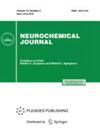血管性认知障碍和抑郁症中青年患者血液和泪液中脑源性神经营养因子 (BDNF) 和睫状神经营养因子 (CNTF) 的水平
摘要
摘要 大量研究已经探讨了神经营养因子对血管性认知障碍(VCI)和抑郁症发展的影响。BDNF 水平的变化及其在认知障碍和抑郁症发展过程中的作用在许多方面是相似的。然而,迄今为止,人们对 BDNF 参与血管性脑损伤和抑郁症发展的机制还没有明确的认识。至于 CNTF 对认知障碍和抑郁症发展的影响,尽管 CNTF 在认知障碍和抑郁症的发病中的作用被认为是不容置疑的,但有关 CNTF 的数据(主要是实验数据)就更少了。这项研究的目的是调查 VCI 和抑郁症患者血液和眼泪中 BDNF 和 CNTF 的水平。研究对象包括2017年1月至2023年3月期间入住莫斯科神经精神病学研究与临床中心(MRCCN)的324名患者和健康对照组。参与者分为四组:(1)无抑郁症的血管性轻度认知障碍(113名患者,平均年龄(71.1 ± 9.74)岁);(2)无抑郁症的血管性痴呆(69名患者,平均年龄(70.7 ± 8.59)岁);(3)无认知障碍的抑郁症(102名患者,平均年龄(30.7 ± 10.21)岁);(4)健康对照组(40名参与者,平均年龄(47.6 ± 22.01)岁)。所有患者均接受了神经和精神检查,包括贝克抑郁量表、迷你国际神经精神访谈(M.I.N.I.)、蒙特利尔认知评估测试(MoCA)和迷你精神状态检查(MMSE)、磁共振成像(MRI)、血清和泪液中的 BDNF 和 CNTF 水平评估。统计分析采用曼-惠特尼 U 检验、卡方检验和斯皮尔曼等级相关检验。显著性水平为 P < 0.05。在 VCI 患者的血液和泪液中观察到痴呆症患者的 BDNF 水平下降。MCI 和痴呆症患者泪液中的 CNTF 水平明显低于同龄健康人。在没有认知障碍的人和 MCI 患者中,血液中的 BDNF 水平与年龄呈显著负相关,而在痴呆症患者中,这种相关性消失了。在中青年抑郁症患者中,血液 BDNF 水平与年龄没有相关性。在抑郁症患者中,血液和泪液中的 BDNF 水平与健康的中青年人之间的正相关性消失了。单相抑郁症和双相抑郁症患者的血液和泪液 BDNF 水平及其相关性没有差异。与同龄健康人相比,中青年抑郁症患者血液和泪液中的 CNTF 水平升高,但与非抑郁症患者一样,血液中的 CNTF 与泪液中的 CNTF 之间没有显著相关性。中青年健康人和同龄抑郁症患者血液和泪液中的 BDNF 和 CNTF 水平之间没有相关性。Abstract
The influence of neurotrophic factors on the development of vascular cognitive impairment (VCI) and depression has been investigated in a large number of studies. Changes in BDNF levels and its role in the development of cognitive impairment and depression are similar in many ways. However, to date, there is no clear understanding of the mechanisms of BDNF involvement in the development of VCI and depression. Even less data, mainly experimental, are available on the influence of CNTF on the development of cognitive disorders and depression, although its role in their genesis is considered indisputable. The aim of the study was to investigate the levels of BDNF and CNTF in blood and tears of patients with VCI and depression. The study included 324 people admitted to the Moscow Research and Clinical Center for Neuropsychiatry (MRCCN) and healthy controls from January 2017 to March 2023. Participants were divided into four groups: (1) vascular mild cognitive impairment without depression (113 patients, mean age 71.1 ± 9.74 years); (2) vascular dementia without depression (69 patients, mean age 70.7 ± 8.59 years); (3) depression without cognitive impairment (102 patients, mean age 30.7 ± 10.21 years); (4) healthy controls (40 participants, mean age 47.6 ± 22.01 years). All patients underwent neurological and psychiatric examination including Beck depression inventory, Mini International Neuropsychiatric Interview (M.I.N.I.), Montreal Cognitive Assessment Test (MoCA), and Mini-Mental State Examination (MMSE), magnetic resonance imaging (MRI), BDNF and CNTF levels assessment in serum and lacrimal fluid. For statistical analysis we used Mann-Whitney U-test, chi-squared test, Spearman rank correlation. The level of significance p < 0.05. In VCI patients, decreased BDNF levels in blood and tears are observed in dementia. The level of CNTF in tears is significantly lower in MCI and dementia than in healthy individuals of the same age. In people without cognitive impairment and in MCI there is a significant negative correlation of blood BDNF level with age, in dementia this correlation is lost. In depression in young and middle-aged people, there is no correlation of blood BDNF levels with age. In depression, the positive correlation between blood and tear BDNF levels present in healthy young and middle-aged individuals is lost. Blood and tear BDNF levels and their correlations do not differ in patients with unipolar and bipolar depressive disorders. Young and middle-aged depressed patients with depression have elevated levels of CNTF in blood and tears compared to healthy individuals of the same age, but as in non-depressed individuals, there is no significant correlation between CNTF in blood and CNTF in tears. There is no correlation between BDNF and CNTF levels in blood and tears in healthy young and middle-aged individuals and in depressed patients of the same age.

 求助内容:
求助内容: 应助结果提醒方式:
应助结果提醒方式:


